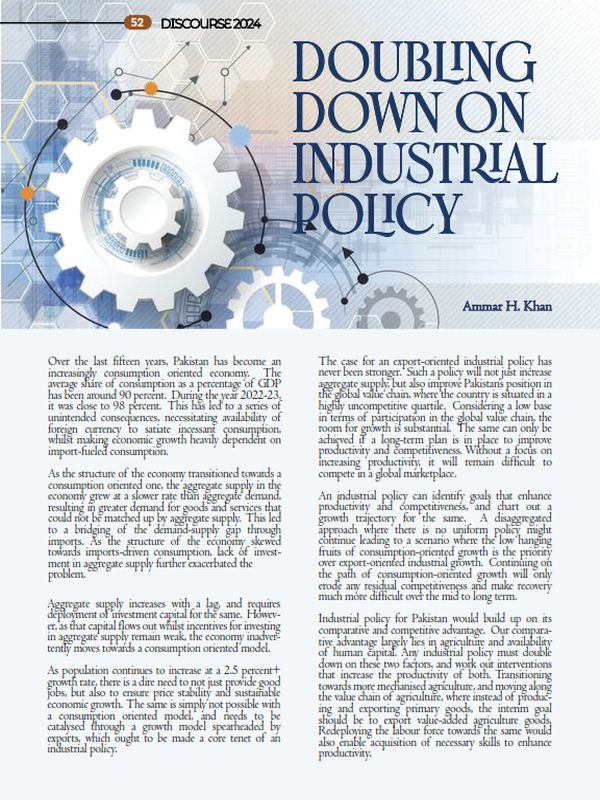
Pakistan Institute of Development Economics
- Home
Our Portals
MenuMenuMenuMenuMenuMenuMenu - ResearchMenuMenuMenuMenuMenuMenuMenu
- Discourse
- The PDR
- Our Researchers
- Academics
- Degree Verification
- Thesis Portal
- Our Portals
Doubling Down on Industrial Policy
Over the last fifteen years, Pakistan has become an increasingly consumption oriented economy. The average share of consumption as a percentage of GDP has been around 90 percent. During the year 2022-23, it was close to 98 percent. This has led to a series of unintended consequences, necessitating availability of foreign currency to satiate incessant consumption, whilst making economic growth heavily dependent on import-fueled consumption.
As the structure of the economy transitioned towards a consumption oriented one, the aggregate supply in the economy grew at a slower rate than aggregate demand, resulting in greater demand for goods and services that could not be matched up by aggregate supply. This led to a bridging of the demand-supply gap through imports. As the structure of the economy skewed towards imports-driven consumption, lack of investment in aggregate supply further exacerbated the problem.
Aggregate supply increases with a lag, and requires deployment of investment capital for the same. However, as that capital flows out whilst incentives for investing in aggregate supply remain weak, the economy inadvertently moves towards a consumption oriented model.
As population continues to increase at a 2.5 percent+ growth rate, there is a dire need to not just provide good jobs, but also to ensure price stability and sustainable economic growth. The same is simply not possible with a consumption oriented model, and needs to be catalysed through a growth model spearheaded by exports, which ought to be made a core tenet of an industrial policy.
The case for an export-oriented industrial policy has never been stronger. Such a policy will not just increase aggregate supply, but also improve Pakistan’s position in the global value chain, where the country is situated in a highly uncompetitive quartile. Considering a low base in terms of participation in the global value chain, the room for growth is substantial. The same can only be achieved if a long-term plan is in place to improve productivity and competitiveness. Without a focus on increasing productivity, it will remain difficult to compete in a global marketplace.
An industrial policy can identify goals that enhance productivity and competitiveness, and chart out a growth trajectory for the same. A disaggregated approach where there is no uniform policy might continue leading to a scenario where the low hanging fruits of consumption-oriented growth is the priority over export-oriented industrial growth. Continuing on the path of consumption-oriented growth will only erode any residual competitiveness and make recovery much more difficult over the mid to long term.
Industrial policy for Pakistan would build up on its comparative and competitive advantage. Our comparative advantage largely lies in agriculture and availability of human capital. Any industrial policy must double down on these two factors, and work out interventions that increase the productivity of both. Transitioning towards more mechanised agriculture, and moving along the value chain of agriculture, where instead of producing and exporting primary goods, the interim goal should be to export value-added agriculture goods. Redeploying the labour force towards the same would also enable acquisition of necessary skills to enhance productivity.
Another component of industrial policy in the country would be co-opting industries that are still heavily dependent on human intervention. It is to be noted that as various economies move along the growth trajectory to advanced stages, there will be industries that will be up for grabs, and this is where we should redeploy our labour force. Such a policy can also not be looked at in isolation, and needs to be concurrently pushed with a plan to upgrade technical ability and productivity of labour, and the same can only be done through an aggressive rollout of literacy and advanced skills programs across the board.
Similarly, in order to develop an export oriented industrial base, regional connectivity and increasing trade within the region is also critical. Inability to develop export markets within the region will continue to act as a drag on the country, as export competitiveness in markets that are geographically distant will always be low relative to markets that are in proximity.
Effectively, an industrial policy isn’t just restricted to developing an industrial base, but it is about aligning trade, human capital, and other factors in a manner such that optimal outcomes can be generated. Without effective coordination, this objective will be compromised by one factor or another – thereby necessitating development of an industrial policy.
Moreover, an industrial policy does not mean an inward looking structure that makes production uncompetitive. But it is about iterating different options such that they may lead to optimal outcomes, which in this case is export oriented industrial growth.
The author is an independent macroeconomist. He can be found on Twitter as @rogueonomist.



